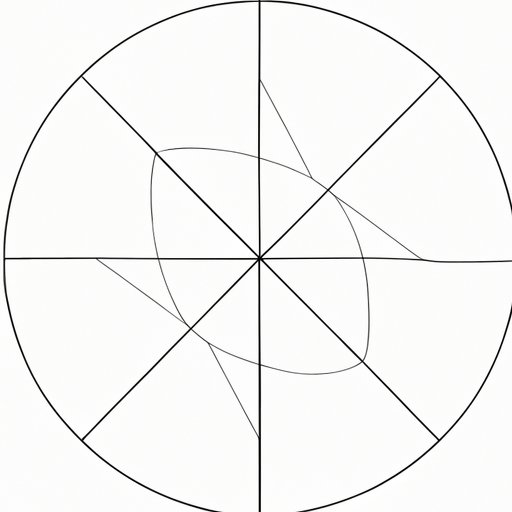
Introduction
Knowing how to find the radius of a circle is an essential skill for students studying geometry, as well as for professionals in various fields, such as engineering and architecture. Radius refers to the distance from the center of the circle to its edge, and it is used in several formulas related to circles.
This article will provide a comprehensive guide on how to calculate the radius of a circle, from the basic formula to tips and tricks for quick estimations. So, let’s dive into the world of circles!
Mastering the Formula: A Guide to Finding the Radius of a Circle
Before we get into the formula, let’s first define what the radius represents in a circle. The radius of a circle is defined as the distance from the center of the circle to any point on its edge. It is represented by the symbol “r.” The radius is half the length of the diameter (d) of a circle.
The formula to find the radius of a circle is:
r = d/2
Where “d” represents the diameter of a circle. Therefore, dividing the diameter by 2 will give us the value of the radius.
Step-by-Step Instructions for Calculating the Radius of a Circle
To calculate the radius of a circle using the formula mentioned earlier, follow these steps:
- Identify the diameter of the circle.
- Divide the diameter by 2.
- The result will be the radius of the circle.
For example, suppose you have a circle with a diameter of 10 cm. To find its radius:
- Identify the diameter: d = 10 cm
- Divide the diameter by 2: 10/2 = 5
- The radius of the circle is 5 cm
As you can see, the formula to find the radius of a circle is relatively straightforward to apply.
The Ultimate Cheat Sheet for Determining the Radius of Any Circle
For some common circle diameters, you can quickly determine their radius without going through the calculation process each time. Here are some common diameters and their corresponding radii:
- A diameter of 10 cm corresponds to a radius of 5 cm
- A diameter of 20 cm corresponds to a radius of 10 cm
- A diameter of 30 cm corresponds to a radius of 15 cm
- A diameter of 40 cm corresponds to a radius of 20 cm
Now, what if you come across a circle with an odd diameter that you don’t have memorized? You can use estimation to get a quick idea of the radius. Here are some tips for estimating the radius without a calculator:
- Use an object with a known length to compare with the diameter of the circle. For example, if you have a 15 cm ruler, you can hold it against the diameter to see if the diameter is closer to 15 or 30 cm.
- Divide the diameter by 2 mentally. You can round the result to the nearest whole number if a precise value is not necessary.
- Use common fractions to estimate the radius. For instance, if the diameter is 13 cm, you can estimate the radius as a fraction of 13, such as 6 1/2 cm or 6.5 cm.
The Importance of Knowing How to Find the Radius of a Circle: A Comprehensive Tutorial
Now that we’ve covered how to find the radius let’s explore some of the real-world applications of this knowledge.
The radius is used in several formulas related to circles, which can be applied to many fields, including:
- Architecture: Finding the radius is useful to determine the dimensions of a circular building, such as a dome or rotunda.
- Engineering: Many engineering designs rely on the geometry of circles and cylinders, requiring the calculation of the radius. For instance, determining the radius is useful to design bearings or calculate the volume of a cylinder.
- Physics: A circle can represent the motion of an object, such as the orbit of a planet, or a satellite around the Earth. In many physics problems, it is essential to know the radius of the circle’s path, which can provide insights into the object’s motion.
Knowing how to find the radius can help you with a variety of tasks, from measuring round objects to solving complex problems in different fields.
Ready, Set, Math: Tips and Tricks for Quickly Calculating the Radius of a Circle
Here are some tips and tricks to make finding the radius of a circle even easier:
- To find the diameter, double the radius. So, if you know the radius, you can quickly find the diameter without using the formula.
- Use the Pythagorean Theorem to find the radius if you only know the circumference of the circle. The formula is: r = c/(2π), where “c” is the circumference of the circle and “π” is pi.
- Divide the area of the circle by π, and then take the square root of the result to find the radius. The formula is: r = √(A/π), where “A” is the area of the circle.
Conclusion
In conclusion, knowing how to find the radius of a circle is an essential skill for various fields, from architecture to physics. The formula for calculating the radius is simple (r = d/2), and with a little practice, you can calculate the radius quickly and efficiently.
If you ever forget the formula, don’t worry, just remember that the radius is half the diameter! With the tips and tricks provided here, you’ll be mastering the art of finding the radius in no time.




